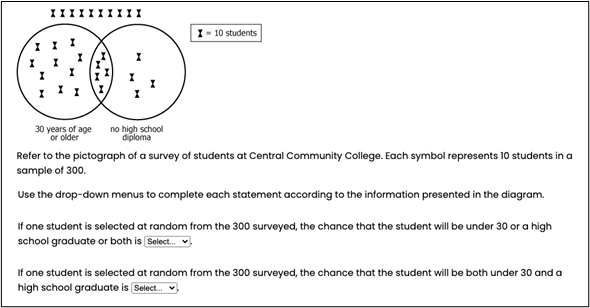Are you thinking about getting a Master’s in Business Administration (MBA)? To do so, you’ll probably have to take the GMAT—a standardized test that assesses your analytical writing, integrated reasoning, quantitative reasoning, and verbal reasoning skills, providing MBA program admissions committees with a common benchmark for comparing applicants.
If you’re reading this, you likely have questions like: Is the GMAT the only exam accepted by business schools? What should you know before registering to take the exam?
So, in this blog post, we'll provide you with an in-depth overview of the GMAT, answering common questions like:
What exactly is the GMAT?
Who needs to take this exam?
What is the GMAT for?
What's on the exam?
How long is the GMAT?
How challenging is the exam?
How do you study for the GMAT?
How much does the GMAT cost?
How do you register for the exam?
Let’s begin!
TABLE OF CONTENTS
(click to skip ahead)What is the GMAT?
Designed to evaluate your aptitude in critical areas for business schools, the GMAT is a standardized exam for individuals aspiring to pursue a Master’s degree in business. These degrees include not only the popular Master’s in Business Administration but also other business-related programs such as Master's in Finance, Master's in Marketing, and Master's in Data Analytics.
Accepted by business schools worldwide, the GMAT evaluates your readiness for advanced studies in these fields, specifically assessing your critical thinking, analytical writing, verbal reasoning, and quantitative reasoning skills.
What does GMAT stand for?
The "GMAT" stands for the Graduate Management Admission Test. The exam is administered by the Graduate Management Admission Council (GMAC), a trusted organization dedicated to facilitating the admissions process for business schools.
Who needs to take the GMAT?
If you aspire to pursue a Master’s in Business Administration (MBA) or other business-related graduate programs, you should seriously consider taking the GMAT. Most business schools require GMAT scores as part of their admissions process.
However, a growing number of business schools also accept scores from the Graduate Record Examination (GRE). If you prefer to take the GRE instead of the GMAT, check the specific admissions requirements of each program you are interested in. The GRE only satisfies the standardized testing application requirement at some business schools.
What is the GMAT for?
The GMAT plays a pivotal role in the admissions process for graduate-level business programs. It serves multiple purposes that make it a valuable component of your application.
Standardized evaluation
The GMAT provides a standardized measure for business schools to assess applicants fairly and equally. Unlike undergraduate GPAs achieved with varying degrees of difficulty across academic institutions, the GMAT gives admissions a better understanding of your academic strengths.
Benchmarking applicants
By considering GMAT scores, business schools establish a benchmark for comparing applicants. This standardized benchmark then allows them to identify candidates with the necessary academic skills and potential to excel in their graduate school programs.
Comprehensive skill assessment
From verbal and quantitative reasoning to analytical writing, the GMAT assesses a wide range of skills critical for success in Master’s level business degree programs.
What's on the GMAT?
The GMAT consists of four distinct sections that evaluate various skills essential for business school students. Let's explore each section and the skills required to perform well.
GMAT Analytical Writing Assessment (AWA)
In this section, you will be presented with an argument and tasked with critically analyzing it and constructing a well-structured written response. You’ll need to articulate your thoughts effectively, support your arguments with logical reasoning, and demonstrate your ability to communicate ideas coherently within a time constraint.
GMAT Integrated Reasoning (IR)
The IR section assesses your ability to interpret and analyze complex information in multiple formats, including tables, graphs, and text passages. You'll be required to draw connections between different pieces of information, evaluate data relationships, and solve problems using critical thinking skills.
GMAT Quantitative Reasoning (QR)
In the QR section, you'll encounter problem-solving and data-sufficiency questions, requiring you to apply mathematical concepts, analyze information, and make accurate calculations efficiently. To excel, you’ll need a strong foundation in mathematical principles, including algebra, arithmetic, geometry, and basic statistics.
GMAT Verbal Reasoning (VR)
The VR section measures your ability to analyze and interpret written passages, evaluate arguments, and identify errors in sentence structure and grammar. To do well in this section, you’ll need a strong command of the English language and effective reading comprehension skills.
How long is the GMAT?
The total duration of the GMAT is 3 hours and 7 minutes. Here's a breakdown of the duration and number of questions for each section of the GMAT:
| Section | Duration | Number of Questions |
|---|---|---|
| Analytical Writing Assessment (AWA) | 30 minutes | 1 essay |
| Integrated Reasoning (IR) | 30 minutes | 12 questions |
| Quantitative Reasoning (QR) | 62 minutes | 31 questions |
| Verbal Reasoning (VR) | 65 minutes | 36 questions |
| Two Breaks (Optional) | 8 minutes each | — |
| Total | 3 hours, 7 minutes | 80 questions |
How hard is the GMAT?
The GMAT is, undoubtedly, a challenging exam. However, how difficult you find it depends on your strengths, preparation, and familiarity with the test format. Here are several reasons that may contribute to your struggling or feeling stressed about the GMAT.
Content complexity
The GMAT covers a wide range of topics, including analytical thinking, effective communication, data interpretation, mathematical reasoning, and reading comprehension. The depth and complexity of these topics can pose challenges if you are less familiar with or experienced in certain areas.
Time pressure
The GMAT is a timed exam, and managing time effectively within each section can be demanding. You’ll need to answer questions accurately and efficiently while keeping track of the time remaining for each section.
Test anxiety
The high-stakes nature of the GMAT can lead to test anxiety for many individuals. Nervousness, self-doubt, and fear of failure can affect concentration and performance during the exam. It's important to develop strategies to reduce test anxiety, such as relaxation techniques, positive self-talk, and adequate preparation.
Lack of preparation and familiarity
If you don’t familiarize yourself with the test structure, question types, and time management strategies, you may find the GMAT harder than needed. It's important to dedicate sufficient time to study, take practice tests, and seek guidance on any particularly challenging areas.
Computer-adaptive format
If you take the GMAT online, the test will have a computer-adaptive format. This can add an extra layer of difficulty if you’re unfamiliar with this format. As you answer questions, the test adapts to your performance. That means the questions can become progressively more challenging. Some find this format intimidating and feel that it pressures test-takers to perform well from the beginning.
How to study for the GMAT
Studying for the GMAT requires a structured approach and diligent preparation. Here are some tips and recommendations to help you develop the most efficient study plan.
Understand the exam
Familiarize yourself with the format, sections, and question types of the GMAT. This will help you create a study plan tailored to the exam's specific content and timing requirements.
Take a diagnostic test
Start by taking a diagnostic test to assess your strengths and weaknesses. This will help you identify areas that require more attention and guide your study plan.
Create a study plan
Develop a comprehensive study plan that outlines your timeline, study schedule, and topics that require more attention (e.g., if you have a harder time with QR than with VR, map out how you will spend more time on QR practice). Remember to set realistic targets and give yourself sufficient time for each section.
Simulate test conditions regularly
When taking practice exams, create a test-like environment with similar time constraints and minimal distractions. This will help you adapt to the pressure and conditions of the actual exam.
Use official GMAT study materials
Use official GMAT study materials provided by GMAC. These resources align with the exam's content and question types, accurately representing what you'll encounter on test day.
Practice, practice, practice
Dedicate ample time to practice questions and full-length practice exams. This will familiarize you with the GMAT format, improve your speed and accuracy, and help you develop effective test-taking strategies.
Review mistakes and focus on weak areas
If you want to get better, take time to understand the underlying concepts, identify patterns in your mistakes, and work on strengthening weak areas. It’s also a good idea to devote additional practice sessions to and seek resources specific on those topics.
Practice time management skills
Practicing time management skills during your study sessions can help ensure that you can complete each section within the time limits. This will also help you learn the pacing required for different question types and avoid running out of time on test day.
Seek additional resources
If needed, you can supplement your study materials with GMAT prep books, online courses, or tutoring services. These resources can provide additional strategies, explanations, and practice opportunities to enhance your preparation.
GMAT cost
Here's a breakdown of how much the GMAT costs, including registration fees and additional fees:
| Registration Fees | GMAT Test | |
|---|---|---|
| Taken at a Test Center | Taken Online | |
| GMAT Exam |
$275 |
$300 |
| Additional Service Fees |
GMAT Test | |
|---|---|---|
| Taken at a Test Center | Taken Online | |
| Enhanced Score Report |
$30 |
N/A |
| Additional Score Report |
$35 each |
$35 each |
| Cancel Score |
$25 |
N/A |
| Reinstate Score |
$50 |
N/A |
| AWA Essay Rescoring |
$45 |
$45 |
| Reschedule Fees |
GMAT Test | |
|---|---|---|
| Taken at a Test Center | Taken Online | |
| More than 60 days before test day |
$55 | $60 |
| 15-60 days before test day |
$110 | $120 |
| 14 days or less before test day |
$165 | $180 |
| Cancellation Fees | GMAT Test | |
|---|---|---|
| Taken at a Test Center | Taken Online | |
| More than 60 days before test day |
$110 refund | $120 refund |
| 15-60 days before test day |
$80 refund | $90 refund |
| 14 days or less before test day |
$55 refund | $60 refund |
GMAT registration
Ready to register for the GMAT? Follow these steps:
Step 1 - Create an account
Visit the official GMAT website and create an account. Provide the required information, including your name, contact details, and email address. Ensure that the information you provide is accurate and matches your identification documents.
Step 2 - Select a test center or the GMAT online
Choose a test center convenient for you from the available options. Or you can also choose to take the GMAT online from the convenience of your home.
Step 3 - Choose a test date
Select a test date that suits your schedule and allows you sufficient time for preparation. The GMAT is available throughout the year, but popular dates at in-person test centers may fill up quickly. If you choose to take the GMAT online, test date options will be available around the clock. For the in-person and online versions of the GMAT, you can schedule your test date up to six months in advance.
Step 4 - Review policies and procedures
Familiarize yourself with the GMAT policies and procedures. Ensure you understand the test day rules, identification requirements, test center guidelines, and security measures. This will ensure a smooth and hassle-free experience on test day. (Don’t underestimate how your mental state before the exam can affect your performance during the exam.)
Step 5 - Pay the registration fee
Next, you’ll pay the GMAT registration fee, currently $275 for in-person testing or $300 for online testing. You can make the payment using a credit card, debit card, or other accepted forms of payment. Make sure to check that your payment is processed successfully.
Step 6 - Receive confirmation
After successful registration and payment, you will receive a confirmation email containing important details such as your test date, test center location, and reporting time. Review this information carefully and mark it on your calendar.
Final thoughts
Whether you're aspiring to pursue an MBA or another business-related graduate program, the GMAT is an important step in the MBA admissions process. We hope this guide has provided you with valuable insights and clarity about the exam.
If you’d like to explore options for further guidance and support while applying to business school programs, our graduate school admissions consultants are here to assist you. From crafting a compelling personal statement to navigating the admissions process, our consultants can provide valuable insights and expertise.
If you want to talk things through, feel free to schedule a consultation and begin taking the next step in your business school journey!
Ameer is a freelance writer who specializes in writing about college admissions and career development. Prior to freelancing, Ameer worked for three years as a college admissions consultant at a Hong Kong-based education center, helping local high school students prepare and apply for top colleges and universities in the US. He has a B.A. in Latin American Studies from the University of Chicago and an M.A. in Spanish Linguistics from UCLA. When he’s not working, Ameer loves traveling, weight lifting, writing, reading, and learning foreign languages. He currently lives in Bangkok, Thailand.
Top values: Growth / Diversity / Empathy















